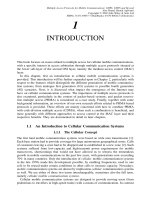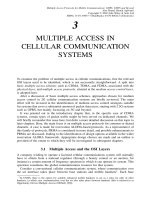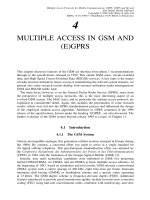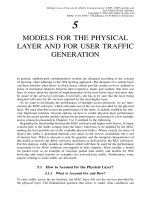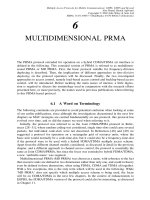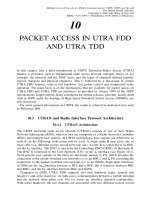Áp dụng DSP lập trình trong truyền thông di động P1 ppt
Bạn đang xem bản rút gọn của tài liệu. Xem và tải ngay bản đầy đủ của tài liệu tại đây (276.3 KB, 10 trang )
1
Introduction
Edgar Auslander and Alan Gatherer
This book is about two technologies that have had, and will increasingly have, a significant
impact on the way we all live, learn and play: personal wireless communications and signal
processing. When it comes to both markets, history has shown that reality has often surprised
the most optimistic forecasters.
We draw on the experience of experts from MIT, Berkeley, UCLA, Worcester Polytechnic
Institute, INRIA, Authentec, Radioscape, Geovector and Texas Instruments, to give a
description of some of the important building blocks and implementation choices that
combine both technologies, in the past and in the future. We highlight different perspectives,
especially regarding implementation issues, in the processing of speech, audio, video, future
multimedia and location-based services as well as mobile commerce and security aspects.
The book is roughly divided into three sections:
† Chapters describing applications and their implementations on what might be described as
‘‘today’s’’ technology. By this, we mean the use of programmable Digital Signal Proces-
sors (DSPs) and ASICs in the manner in which they are being used for today’s designs. In
these chapters, we highlight the applications and the role of programmable DSPs in the
implementation.
† Chapters that present challenges to the current design flow, describing new ways of
achieving the desired degree of flexibility in a design by means other than programmable
DSPs. Whether these new approaches will unseat the programmable DSP from its perch
remains to be seen, as the commercial value of these approaches is less certain. But they
give a detailed overview of the directions researchers are taking to leap beyond the
performance curve of the programmable DSP approach.
† We conclude with a practical yet innovative application example, a possible flavor of the
exciting new personal communications services enabled by digital signal processing.
In this introduction, we overview the aspects of mobile communications that make it a
unique technology. We describe how the applications associated with mobile communica-
tions have evolved from the simple phone call into a slew of personal technologies. These
technologies, and their implementation, are described in more detail in the subsequent chap-
ters.
The Application of Programmable DSPs in Mobile Communications
Edited by Alan Gatherer and Edgar Auslander
Copyright q 2002 John Wiley & Sons Ltd
ISBNs: 0-471-48643-4 (Hardback); 0-470-84590-2 (Electronic)
1.1 It’s a Personal Matter
The social impacts and benefits of personal wireless communications are already visible.
When phones were not portable and used to only sit on a desk at home or at work, people
would call places: work or home; but when phones became portable and accessible anywhere,
people began to call people rather than places: today, when we call people we even often start
by asking ‘‘ Hello, where are you?’’ . The mobile phone has become a safety tool: ‘‘ I will bring
the phone with me in case I need to call for an emergency, if anxious family members want to
reach me, or if I am lost’’ . The mobile phone has become a social tool, enabling more flexible
personal life planning: ‘‘ I do not know where I will be at 2 p.m. and where you will be, but I
will call you on your mobile and we will sync’’ . A recent survey has shown that when people
forget their mobile phone at home, a vast majority is willing to go back home to get it, even
when it implies a 30-minute drive. The mobile phone has become a personal item you carry
with you like your wallet, your drivers’ license, your keys, or even wear, like a watch, a pen,
or glasses: it made it to the list of the few items that you carry with you. If you are a teenager,
a gaming device or an MP3 player also made their room in your pocket, and if you are a busy
executive a personal organizer is maybe more likely to have this privilege. Figure 1.1
illustrates the integration of new features trend; conversely, the wireless communication
technology will be pervasive in different end-equipments and create new markets for wireless
modules embedded in cars for example.
To some, the use of a mobile phone in public places is an annoyance. Peer pressure
‘‘ dictates’’ you have a mobile phone to be reachable ‘‘anywhere any time’’ ; not having a mobile
phone becomes anti-social in Scandinavian countries for example, where penetration is higher
than 70% of the whole population. Like for every disruptive technology widely used, a
new etiquette has to be understood and agreed upon, e.g. phones have to be turned off or put
The Application of Programmable DSPs in Mobile Communications2
Figure 1.1 Integration and exportation of functions to and from the mobile phone
in silent mode at concerts or in restaurants. Phones are now programmed with different ringing
profiles that are ‘‘ environment friendly’’ (e.g. meeting mode rings only once and makes the
phone vibrate). Inthe future, we might see phones that are environment aware, with sensors that
detect if the phone is in a bag and needs to ring louder forexample. In the past, Matra-AEG, now
Nokia Mobile Phones, introduced a GSM phone that had an infra-red sensor that served as a
proximity detector so as to put the phone automatically on or off hands-free mode. Ringing
profiles have also other nice applications: paired with CallerID, they enable users to have
different ringing tones for different callers (friends, family, business partners, unknown…).
1.2 The Super Phone?
To the vast majority, the mobile phone is the ultimate telecommunication tool, via voice or
short messages, soon to become multimedia messages or multimedia communications.
For some, it is a foregone conclusion that wireless terminals will continue their mutation
from fairly simple, voice-oriented devices to smarter and smarter systems capable of
increasingly more complex voice and data applications. The argument goes that wireless
phones will take on the capabilities of Personal Digital Assistants (PDAs) and PDAs will
subsume many of the voice communications capabilities of mobile phones. This line of
reasoning proclaims that the handsets of the future eventually will become some sort of
super-phone/handheld computer/PDA. But in the end, the marketplace is never nearly as
neat and tidy as one might imagine. Rather than an inexorable quest for a one-size-fits-all
super-phone, the fractious forces of the market, based as they are on completely illogical
human emotions, no doubt will lead handset manufacturers down a number of avenues in
support of 2.5G and 3G applications (2.5 and 3G refer to coming phone standard genera-
tions to be described later in this book). Many mobile handsets will be capable of converged
voice/data applications, but many will not. Instead, they will fulfill a perceived consumer
need or perform a certain specialized function very well. Rather than a homogenous market
of converged super-phones, the terminal devices for next generation applications will be as
diverse as they are today, if not more so. And they will be as diverse as the applications that
will make up the 2.5G and 3G marketplace. Mobile device OEMs must be prepared to meet
the challenge of a diverse and segmented market. Figure 1.2 illustrates how wireless phone
service started to be affordable to a few privileged business professionals and how it
diversified in time to become a consumer item. The high-end phone of today is the classic
phone of tomorrow as fashion and technology evolve and as people become used to inno-
vations brought to them.
We believe that the increasing need for function diversification will drive the program-
mable DSP into an even more integrated role within the mobile devices of tomorrow. Non-
programmable DSP architectures will have to take on many traits of the programmable DSP
in order to compete with it. The later chapters of this book highlight that the future of
programmable DSPs in mobile applications hinges on their ability to bring the right level
of flexibility, along with low power performance.
Over the last several years, the market for terminals first became polarized and then
stratified. The market first polarized at the high and low ends of the spectrum. As more
features and functions could be added to handsets, they were and this made up the high
end. But to attract new subscribers, wireless carriers still wanted low-end, low-cost yet robust
Introduction 3
mobile phones. In fact, for the service provider offering free handsets to each new subscriber,
the lower the cost of the handset, the better off the service provider would be.
In the last few years though, the market has shown that it will splinter and stratify with
several different layers or market segments between the poles. Some of the distinct segments
that are emerging can be defined as:
† Data-centric devices: evolving from the PDA, these advanced palmtop computers will be
integrated with cellular voice and retain or even expand upon their computing capabilities.
Data-centric devices can also be modem cards (no keyboard, no display!) that can be
plugged into laptops.
† Smart-phones: migrating from the cellular telephone segment of today’s market, smart-
phones will perform their voice communications functions quite effectively, but they also
will be equipped with larger display screens so they can begin to perform new applications
like e-mail access, Internet browsing and others.
† Fashion phones: these devices will use fashion techniques to appeal to several segments of
consumers. The businessperson, for example, will be attracted to a certain look and feel to
make a fashion statement. Younger consumers will have quite different tastes. Although
they will cross several demographic market segments, these types of phones will appeal to
buyers who are fashion-conscious and who will use fashion to make a statement about
their lifestyles.
† Classic mobile phones: for users who are looking for a workhorse mobile phone, the
classic handset will be small and easy-to-handle, and it will perform effectively the
most frequently used communications features.
The Application of Programmable DSPs in Mobile Communications4
Figure 1.2 Digital cellular phones segments dynamics
† Low-end phones: service providers will continue to offer free phones with service
contracts. These small, light and robust phones will remain a mainstay in the market
because they perform a very valuable function. They often come with a pre-paid calling
plan bundle. They attract first-time users. In the future, we might see such phones without
a keyboard or a display (to save cost): phone calls would be made via an operator sitting in
a call center or a voice dialing/recognition system, most likely in the network.
† Bluetooth-enabled phones: Bluetooth is a short range, low-cost, low power wireless tech-
nology operating in the 2.4 GHz unlicensed band. Bluetooth-enabled phones can be any of
the above categories, but the form factors may change dramatically as the phone will now
be distributed around your body.
The types of handsets that can be identified are illustrated in Figure 1.3 (concept phones
courtesy of Nokia). What is not known is what tomorrow may hold and the effects new
applications will have on the size, shape and function of future terminal devices.
One thing is for certain: new technologies will be developed that will alter the form factors
in use today. For example, a Bluetooth-enabled phone maybe a belt-attached controller/
gateway device linked to an ear piece that communicates audio information. A display
unit of some sort could be connected to the user’s eye glasses for communicating visual
data. And beyond these fairly new applications, medical sensors could be deployed to moni-
tor the person’s heartbeat or other vital functions.
A small box, comparable to a flat pager in size, will incorporate cellular and Bluetooth (or
another technology such as IEEE802.11B or IEEE802.15) functionalities combined, to
communicate with a collection of fashionable accessories; the accessories, of the size and
Introduction 5
Figure 1.3 New form factors
weight of a pen, or a flat screen for example, will form a personal area network of thin clients
communicating via Bluetooth with the small box, the Personal Mobile Gateway (Figure 1.4,
courtesy of IXI Mobile Inc.). That way the ‘‘ all-in-one’’ terminal, often too big to be a phone
and too small to be a PDA, will become a collection of smart yet thin, fashionable and low
cost devices. The concept would appeal to both mobile professionals and teenagers, the
primary target for the ever increasing replacement market.
1.3 New Services
We have discussed wireless devices, but what users really care about are the services those
devices will bring to them, and industry players care about how money will be made. Before
describing the new services that are likely to be offered thanks to personal mobile terminals, a
little history lesson will be useful and remind us to be humble, especially when it comes to
predicting the future! When the telephone was invented, it was originally to improve the
telegraph system. The fundamental idea of the electrical transmitting of sound was published
by Charles Bourseul first in 1854 in the magazine L’Illustration de Paris. Alexander Graham
Bell patented his telephone on the 14 February 1876, just 3 hours before Elisha Gray. Nobody
was interested in his invention first. When he asked the Western Telegraph Company in 1877
to buy his patent for $100,000, the response was ‘‘ What shall we do with a toy like that?’’ .
There was some doubt as to the use to which telephones might actually be put in practice.
Demonstrations often included speech, song and music, and it was not uncommon for the
musical demonstrations to be technically the most successful. ‘‘ The musical telephone’’ was a
major attraction at the International Electrical Exhibition in Paris in 1881, where the French
engineer Cle
´
ment Ader demonstrated stereophonic transmission by telephone direct from the
stages of the Paris Opera House and the Come
´
die Franc¸aise. It was believed to be the
major application of telephony. In 1890, a commercial company, Compagnie du Theatro-
phone (Figure 1.5), was established in Paris, distributing music by telephone from various
theatres to special coin-operated telephones installed in hotels, cafe
´
s, etc. and to domestic
subscribers. The service continued until 1932, when it was made obsolete by radio broad-
The Application of Programmable DSPs in Mobile Communications6
Figure 1.4 Personal Mobile Gateway
TM
(IXI Mobile Inc.)
casting. The phone has come a long way since then, and the first mass market application is
simply… talking with other people.
With the advent of the Internet and wireless data services, a new realm of possibilities are
already offered, that go far beyond ‘‘ just talking with other people’’ , as witnessed by the
recent success of NTT DoCoMo’s I-mode service in Japan. Service categories of the near
future will encompass personalized information delivery for news, location-dependant
services, travel, banking and personal hobbies; it will also include productivity-related
services such as Virtual Private Network (VPN) with the office or the family, personal
assistant, agendas, and address books; extended communication, including e-mail, postcard
transmission, and of course entertainment. Nokia has already introduced phones with games
such as ‘‘ the snake’’ , but the future will bring much more exciting games (on-line as well as
off-line, puzzles, gambling) and new forms of entertainment: music (ringtones, clips and
songs), TV (schedules, clips), chat groups, astrology, dating services and what is sometimes
called ’’ adult entertainment’’ . Figure 1.6 shows some of the service categories.
The successful deployment of the services will depend on ease of use, convenience,
pertinence, and clear affordable billing. The pertinence of the service will require persona-
lization; profiling technology can be used to match content to the needs of the users. Loca-
tion-based services will enable or facilitate such profiling. Of course localization will have to
be volunteered and ‘‘legally-correct’’ information. Most mobile location-based services today
use positioning based on Cell of Origin (COO), but the precision is often mediocre, linked to
cell size; in some cases, this is acceptable enough. Another method, known as Enhanced
Observed Time of Difference (EOTD) is used in some GSM networks. Time of arrival signals
from base stations are measured by the phone and what is called a Location-Measurement
Unit (LMU). In future UMTS systems, a similar technique will be used that is known as
Introduction 7
Figure 1.5 The Theatrophone
Observed Time Difference of Arrival (OTDOA). The location methods we just talked about
only use the network and LMUs as a means to get location information; the use of Global
Positioning System (GPS) gives better results, but the cost of a GPS receiver has to be added
to the phone. An illustration of an innovative way to exploit and present location-based
services is given in the last chapter of the book.
1.4 The Curse and Opportunity of Moore’s Law
Moore’s law predicted the rapid increase in transistor density on silicon chips. Along with this
increase in transistor density, came an increase in clock speed, chip size, and component
density on boards. All this has given the system designer an exponentially increasing amount
of processing power to play with in his or her quest for more and more sophisticated systems.
The design community has reacted to this explosion by making less and less efficient use of
the transistors offered to it. This has been true since we first moved from hand laid out
transistors to logic gates. The latter is less efficient in terms of silicon area and speed
optimization, but is much more efficient in terms of a more precious resource: human intel-
lect. From logic to RTL to microprocessors, the designer has moved to an increasingly high
level of abstraction in order to design more and more complex devices in reasonable time-
frames. Despite this, designers continue to lag behind process engineers in their ability to
consume the transistors being made available to them. This can be clearly seen in Figure 1.7
which plots the ability of a designer to use transistors against the availability of transistors
that can be used. This trend makes the use of programmable devices within mobile commu-
nications systems inevitable for the foreseeable future. The only question is, what will these
The Application of Programmable DSPs in Mobile Communications8
Figure 1.6 Service categories
programmable devices look like? Programmable DSPs are programmable devices that
include features that enable efficient implementation of systems within the special class of
signal processing problems. By focusing on signal processing DSP designers have put
programmable DSPs at the heart of many consumer devices, including mobile communica-
tion systems. Recently DSPs have been specialized to perform specifically in the domain of
signal processing for mobile communications (more details are given in Chapter 2). The
balance between specialization and flexibility is important for any DSP to succeed.
As DSPs are programmable, they are not ‘‘ just pieces of silicon,’’ they come with a
development environment. In the early 1980s, DSP was considered black magic, used by
gurus who wrote all applications in assembly language. Now, powerful development tools
including application boards, emulators, simulators, debuggers, optimizing High Level
Language (HLL) compilers, assemblers, linkers, block diagram environments, code genera-
tors, real-time operating systems (enabling easier multitasking, preemptive scheduling, high-
speed context switching, low interrupt latency, and fast, flexible intertask communication) as
well as many DSP-related books and application notes and innovative visual tools have made
DSP technology a tool for rapid design of increasingly complex systems.
In competition to DSPs, ‘‘ silicon compilers’’ have arisen. These compilers promise to take
high level descriptions of a system, and output a design ready for synthesis, usually with a
certain amount of user feedback along the way. Though such tools have shown some success
and are no doubt a useful tool in a designers arsenal, they do not provide a way to modify a
system once it has been fabricated. This is becoming an increasingly important requirement
because systems evolve quickly and are increasingly difficult to specify at design time. For
instance, a mobile handset may not be fully tested until it has been used in the field. The
increasing cost of mask sets for the fabrication of chips means any change that cannot be done
by reprogramming may cost millions of dollars and months of time. This is unacceptable in
today’s marketplace.
1.5 The Book
In this book we attempt to cover some of the important facets of mobile communications
design. We start of with five chapters covering various aspects of the design of the commu-
Introduction 9
Figure 1.7 The widening productivity gap
nications engine itself for 2G, 2.5G, and 3G phones. We then move onto the applications that
will exist on top of the communications engine, covering a wide range of applications from
video through biometric identification to security, for the next seven chapters. Then, after a
chapter on digital radio broadcast, we move onto the architecture section of the book, with
four chapters covering competitors, extensions and comparisons to programmable DSPs. The
final chapter gives a taste of the completely new applications that are waiting to be discovered
in the unique environment created when mobility meets signal processing.
We would like to thank all the contributing authors to this book for all the hard work that
went into producing the excellent chapters within. They are a great example of the expertise
and intelligence that is setting alight the field of mobile computing today.
The Application of Programmable DSPs in Mobile Communications10
